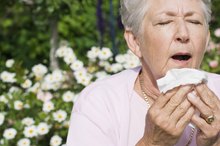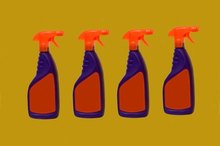Allergy to Paint
Allergies are a common condition that effects nearly everyone at some point in their lives 4. An allergic response is the result of the immune system's overreaction to an unknown particle or substance. Paint allergies can result from the inhalation of strong vapors or contact with the skin 4. Allergy sufferers can use preventative and therapeutic strategies to deal with an allergic reaction to paint.
Allergies Explained
Allergens are foreign substances that provoke an immune response known as allergies in some, but not all people 4. Airborne pollen, dust, mold and animal dander are typical allergens. People also develop allergies to certain foods, drugs and chemicals 4. If you suffer extreme food allergies, you must be very careful about every ingredient in your meals 4. Allergic reactions include runny nose, coughing and sneezing, hives, rash and itchy skin. A severe reaction can be life threatening because swelling tissue cuts off the victim's air supply.
Paint Vapors
Allergy to Cardboard
Learn More
All paints produce vapors that create not only chemical odors in the air, but also an allergic reaction in many people. Coughing, runny nose, sore throat and congestion are standard reactions to paint fumes; sufferers may also experience itchy and watery eyes. Oil-based household paints have many volatile organic compounds, or VOCs, that are particularly well-known allergens, but even water-based paints can cause reactions in certain individuals. A study by Harvard School of Public Medicine and Kalstad University in Sweden linked high rates of asthma, eczema and congestion in children to chemicals found in water-based house paints 1.
- All paints produce vapors that create not only chemical odors in the air, but also an allergic reaction in many people.
- Oil-based household paints have many volatile organic compounds, or VOCs, that are particularly well-known allergens, but even water-based paints can cause reactions in certain individuals.
Paint Contact
Besides inhalation, physical contact is the most frequent means by which allergy sufferers are exposed to allergens. People who experience reactions from touching something often develop contact dermatitis, a localized skin irritation that includes a rash or discolored skin, itchiness and sometimes blistering. Swelling and burning are also typical symptoms of skin allergies 4. The most effective way to ward off skin reactions to paint is to wear adequate clothing and gloves.
- Besides inhalation, physical contact is the most frequent means by which allergy sufferers are exposed to allergens.
- People who experience reactions from touching something often develop contact dermatitis, a localized skin irritation that includes a rash or discolored skin, itchiness and sometimes blistering.
Allergy-Friendly Solutions
What Are the Dangers of Epoxy Paint Fumes?
Learn More
Paint manufacturers continue to formulate products that allergic individuals can use without fear of a crippling reaction, and household paints that produce little or no VOCs are available for sale. If you must work with non-hypoallergenic paints, take precautionary measures. A mask reduces the inhalation of paint fumes, while sleeves and long pants prevent paint from getting on the skin. Seal off areas being painted and open windows to promote good ventilation. If you start to have an allergic reaction to paint, leave the area and go where you can breathe fresh air; rinse irritated skin or eyes with water and apply a cool compress to swelling if necessary; and gargle with warm salt water to relieve throat irritation.
- Paint manufacturers continue to formulate products that allergic individuals can use without fear of a crippling reaction, and household paints that produce little or no VOCs are available for sale.
- If you start to have an allergic reaction to paint, leave the area and go where you can breathe fresh air; rinse irritated skin or eyes with water and apply a cool compress to swelling if necessary; and gargle with warm salt water to relieve throat irritation.
Related Articles
References
- Public Library of Science; Common Household Chemicals and the Allergy Risks in Pre-School Age Children; Hyunok Choi, et al.; October 2010
- Asthma and Allergy Foundation of America: Home Remodeling
- PR Newswire; Valspar Unveils First Paint Certified by the Asthma and Allergy Foundation of America; June 2011
- MedlinePlus: Allergies
- Institute for Quality and Efficiency in Health Care. Allergies: Overview. Updated July 13, 2017.
- Galli SJ, Tsai M, Piliponsky AM. The development of allergic inflammation. Nature. 2008;454(7203):445–454. doi:10.1038/nature07204
- Meltzer EO, Blaiss MS, Derebery MJ, et al. Burden of allergic rhinitis: results from the Pediatric Allergies in America survey. J Allergy Clin Immunol. 2009;124(3 Suppl):S43-70. doi:10.1016/j.jaci.2009.05.013
- Boye JI. Food allergies in developing and emerging economies: need for comprehensive data on prevalence rates. Clin Transl Allergy. 2012;2(1):25. doi:10.1186/2045-7022-2-25
- Klotz JH, Pinnas JL, Klotz SA, Schmidt JO. Anaphylactic Reactions to Arthropod Bites and Stings. American Entomologist. 2009:55(3).
- Goldenberg A, Herro EM, Jacob SE. Contact Dermatitis Allergens. American Academy of Dermatology. Updated 2017.
- Ortiz RA, Barnes KC. Genetics of allergic diseases. Immunol Allergy Clin North Am. 2015;35(1):19-44. doi:10.1016/j.iac.2014.09.014
- Meng JF, Rosenwasser LJ. Unraveling the genetic basis of asthma and allergic diseases. Allergy Asthma Immunol Res. 2010;2(4):215–227. doi:10.4168/aair.2010.2.4.215
- Contact Dermatitis. National Eczema Association.
- Prevention of Allergies and Asthma in Children. American Academy of Allergy Asthma & Immunology.
- Meng JF, Rosenwasser LJ. Unraveling the Genetic Basis of Asthma and Allergic Diseases. Allergy Asthma Immunol Res. 2010;2(4):215–227. doi:10.4168/aair.2010.2.4.215
- Ortiz RA, Barnes KC. Genetics of Allergic Diseases. Immunol Allergy Clin North Am. 2014;35(1):19–44. doi:10.1016/j.iac.2014.09.014
Resources
Writer Bio
Josh Patrick has several years of teaching and training experience, both in the academy and the private sector. He presented original work at the 20th Century Literature Conference in Louisville, Kentucky. Patrick worked for three years on the editorial board for "Inscape," his alma mater's literary magazine. He holds a Master of Library and Information Science.








